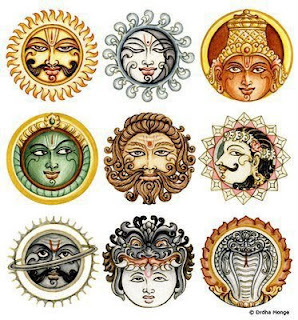Background
How are the days of the week named..? One reason is the order in which the planetary evolution and stabilization happens in the Solar System. Another reason is the 'Hora system'.In Vedic cultures sunrise was the start of the day. A day and night between two sun-rises were divided into 60 ghatis. Every 2.5 ghatis approximately were called a 'Hora'. Hence there were 24 'Horas' between two sun-rises approximately. The 'hour' should have come from the 'Hora'.
The 'horas' were named after the seven luminaries that affect Earth and they were repeated. Thus a 24 horas day and night had these seven luminary names repeating in day.
But the interesting point there is 'order' in which the names of luminaries were chosen for the horas. That order indicates that those days people had indeed known more than what we knew 100 years back.
Synodic period and Sidereal period
Synodic period is the time that elapses between two successive identical configurations as seen from Earth. It is not the real period, but based on how periods are seen from Earth.
Sidereal period is the true period, the time period that actually elapses.
For eg., the synodic period or how the planetary orbits appear from earth and sidereal period which is the actual period of planetary orbits are as follows.
From the above table, it is seen that Moon, Mercury, Venus, Earth, Mars, Jupiter and Saturn are in the ascending order of sidereal orbital periods. Sidereal orbital periods are true orbital periods and not seen from the Earth.
In the Hora system, the horas are named exacly in this ascending order of sidereal orbital periods of luminaries. How did people knew this order, as it is not observed from Earth is a mystery.
The Seven Horas
There are 60 ghatis between Sunrise of two days. In modern time parlance, each ghati is around 24 minutes. 2.5 ghatis or 60 minutes is called a 'Hora'. The hour concept must have come from this 60 minutes, as these definitions are thousands of years old.
The horas are named after the luminaries in the ascendant order of their sidereal periods. How come jyotiS of those days were able to establish this ascending order of sidereal periods is a real mystery as sidereal periods are very different from synodic periods that we are able to observe from Earth.
If we arrange the planets in the ascending order of their sidereal periods or their real orbital periods, then the first 'Hora' is Moon (with shortest orbital period), second Mercury, third Venus, fourth Sun, fifth Mars, sixth Jupiter, seventh Saturn (with longest orbital period). This cycle repeats again with eight hora being moon, ninth mercury, tenth venus etc etc..
- If we start with Moon as the first 'hora', then 25th hora or the first hora of next day will be Mars.
- With Mars as the first hora, the 25th hora or first day of next hora will be Mercury.
- With Mercury as the first hora, the 25th hora or first day of next hora will be Jupiter.
- With Jupiter as the first hora, the 25th hora or first day of next hora will be Venus.
- With Venus as the first hora, the 25th hora or first day of next hora will be Saturn.
- With Saturn as the first hora, the 25th hora or first day of next hora will be Sun.
- With Sun as the first hora, the 25th hora or first day of next hora will be Moon.
Every day is named after the 'first' hora of the day. Hence we get the order of days as Monday (Moon), Tuesday (Mars), Wednesday (Mercury), Thursday (Jupiter), Friday (Venus), Saturday (Saturn) and Sunday (Sun).
But the basis of the above cycle is the hora ordering in terms of their ascending order of sidereal orbital periods.
Rahu kaal
Apart from the horas, a day from sunrise to sunset can be divided into 8 muhurtas. One of these muhurtas is termed 'rAhu kaal' or the time of rAhu.Rahu is the time of vacillation, when we are 'supposed to be vacillating' to take decisions. How did this belief came about..? What is the logic for the 'timings' of these..?
References
1. https://www.vedabhasya.com/2020/03/jyotisa-as-vedanga-part-1.html2. https://www.vedabhasya.com/2020/04/jyotisa-as-vedanga-part-2.html
3. https://www.bighistoryproject.com/chapters/2#our-solar-system
4. https://en.wikipedia.org/wiki/Noachian
5.https://the-universe-of-the-universe.fandom.com/wiki/Timeline_of_Mercury
6. https://watermark.silverchair.com/stv1429.pdf
7. https://the-universe-of-the-universe.fandom.com/wiki/Timeline_of_Jupiter
8. https://earthsky.org/space/mystery-of-jupiters-early-delayed-growth-explained
9.https://the-universe-of-the-universe.fandom.com/wiki/Timeline_of_Saturn
10. https://ase.tufts.edu/cosmos/view_chapter.asp?id=10&page=3
11. https://www.drikpanchang.com/muhurat/hora.html
12. http://veda.wikidot.com/vedic-time-system
13. https://starchild.gsfc.nasa.gov/docs/StarChild/questions/question32.html

This comment has been removed by a blog administrator.
ReplyDelete